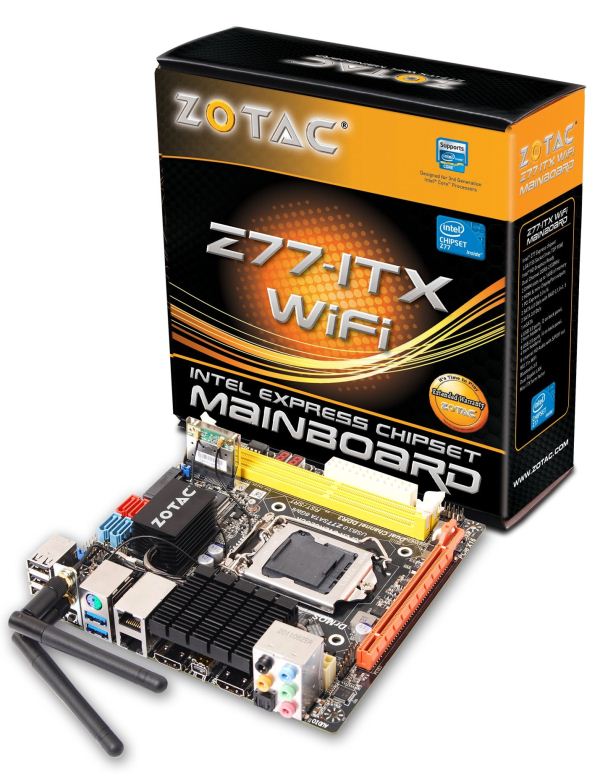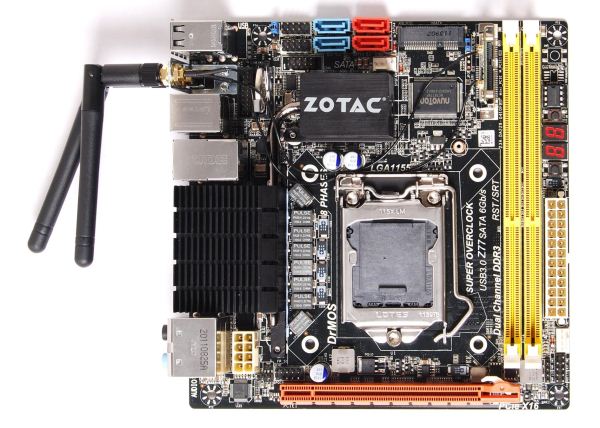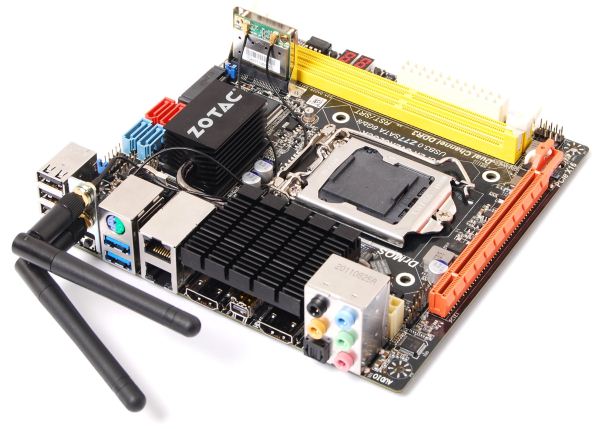Z77 mITX Round-Up: Five of the Best – MSI, Zotac, ASRock, EVGA and ASUS
by Ian Cutress on December 31, 2012 7:00 AM EST- Posted in
- Motherboards
- MSI
- ASRock
- EVGA
- ZOTAC
- Asus
- Ivy Bridge
- Z77
- mITX
Zotac
If you ever wanted small form factor, then Zotac has always been an option, sprouting mITX products for every platform and chipset. With Ivy Bridge and 7-series platforms, Zotac has announced three products so far – two H77 motherboards (-A-E and -B-E), and this motherboard, the Z77-ITX WiFi (also known as the Z77-A-E).
Historically Zotac has not had the ability to innovate as much as the key players in the motherboard industry. Part of this is down to the 'real estate on the PCB of a mITX' factor – the chipset specification deals with a significant amount of the actual hardware on board, but part of it is also due to the size of the company in correlation to their R&D. In this context Zotac fit in the same niche as Biostar – whatever we do see in terms of innovation is few and far between. However every now and again we are pleasantly surprised, as long as it fits into the correct price bracket.
With that, let us start with the Z77-ITX WiFi.
Zotac Z77-ITX WIFI Overview
When testing the Zotac Z77-ITX, I initially ran through the benchmark suite with a high end i7-3770K, and again recently with an i3-3225. In terms of performance, there were several key factors worth noting, such as the slightly slower times in our WinRAR testing compared to other Z77 products. This test relies on the motherboard to apply turbo multipliers given varied load – it is a test that top tier manufacturers seem to do well in, but the lesser manufacturers fall behind. On the plus side, we get a fast POST time (9.18 seconds with a discrete GPU installed), low power usage (20W long idle on a 500W Platinum PSU with a discrete GPU installed, 32W idle) and a sub-200 microsecond DPC Latency test.
Hardware wise, Zotac take a different tack to the video outputs compared to the rest of the Z77 crowd. The Z77 platform with an Ivy Bridge processor allows for 3 digital display outputs and one analogue; most motherboard vendors take this to mean ‘we want one of each output’. Zotac, like Gigabyte, decided to make two of these outputs HDMI to cater for the majority of dual screen home setups (or to supply audio out of one and video out of the other). Rather than give a combination DVI-I port, Zotac also equipped the board with a mDP port and placed in the package a mDP to DP adaptor. If you want a modern digital connection from a Z77 mITX board, Zotac has you covered.
Also relating to hardware, Zotac have given this board a dual NIC as well as WiFi on board, giving network connectivity a high priority. On the downside, we only get a Realtek ALC889, which also failed our RMAA 192 kHz test. The USB 2.0 copy times were quite low, but improved while the CPU was under load, suggesting that some of the BIOS default options are not optimal for USB transfer. The big BIOS option faux pas however is the reluctance for Zotac to move into 2012 and enable AHCI on their SATA ports by default. Also, if you were looking for software for OC or fan control software, unfortunately you will not find them on a Zotac board.
The Zotac Z77-ITX is currently fluctuating wildly in price. When I started the testing for this review, it was at $130. I now see it on Newegg for $163. For the former, it warrants a consideration when weighing up the pros and cons between which Z77 mITX motherboard to choose – having all those extras in the box helps sweeten the deal if you can overlook some of the possible issues.
Visual Inspection
As one of the first Z77 ITX motherboard on the test bed, it is hard not to notice the arrangement of the motherboard as a whole. The location of the socket is very close to the PCIe connector – with the limitations of the mITX platform, the Intel minimum specified distance of components away from the socket (marked by the white box around the socket) is adhered to but only just. This comes into play when we deal with different air coolers on such a platform.
Typically with a Z77 motherboard we see the chipset and additional IO chips to the south of the memory slots, but there is no such luxury on the Zotac Z77-ITX WiFi – we have the chipset located above the CPU, along with our SATA connectivity. In terms of SATA ports, Zotac uses the two SATA 6 Gbps and two SATA 3 Gbps from the chipset for direct SATA connections – another of the SATA 3 Gbps from the chipset is used for the mSATA port to the right of the SATA ports. This should leave one more for an eSATA port on the back IO, but we find no eSATA port.
Fan headers on board are oddly positioned – with a mITX platform I would expect at least two, if not three, and we get two 4-pin headers here. We find a CPU header on the right hand side below the 24-pin ATX power connector and a 4-pin SYS header between the chipset heatsink and the SATA ports. A lot of the space on the right hand side is taken up by the full length DDR3 memory slots – in the past we have seen Zotac switch them out for SO-DIMM memory ports, which could always be an idea for this platform (or if possible, angled SO-DIMM on the back of the board (?)).
The heatsink arrangement for the Zotac covers the chipset above the socket, and the VRM. Zotac have decided to extend the heatsink over the IO panel due to their back panel port arrangement. Even with the fan headers, this should help with cooling if the system were to be pushed with a high wattage chip and an overclock.
The location of the 8-pin CPU power connector is a little odd – we find it on the bottom of the board below the heatsink for the power delivery. This means that any power supply would need to reach over parts of the board in order to connect in. Zotac get around this by including an 8-pin CPU power extension cable in the box, but that still leaves the fact that a cable is somewhere potentially blocking airflow.
Other features directly visible on the board are the mSATA port and the WiFi module, both located above the CPU socket and to the right. The WiFi card is perpendicular to the board itself, and runs two small cables to antenna ports on the back panel – I personally found these cables a little annoying when trying to plug peripherals in to the ports when the board was fixed in a case.
The mSATA port is something that will crop up on mITX boards from now on, providing the possibility of running a smaller form factor if you want to pick up an mSATA SSD. As mSATA densities get higher, this will become more viable for Windows users (where Windows 7 x64 Ultimate requires a drive more than 32GB).
Also on board are various headers for the front panel, the front panel audio, two USB 2.0 headers, a USB 3.0 header (found near the IO), a two-digit debug LED and power and reset buttons. The location of the USB 3.0 header is strange, as in a mITX platform it would more likely be for a front case connector or a separate USB 3.0 panel. It is nice to see a debug LED on board however – I did have to use it a couple of times to determine why the board was failing to boot.
On the back panel, the IO is slightly odd compared to other Z77 motherboards we have encountered. First up is a block of four USB 2.0 ports (I like blocks like this as it gets a lot of USB connectivity sorted), a pair of antenna slots, a ClearCMOS button, a PS/2 combination port, two USB 3.0, dual Realtek NIC, dual HDMI, mini-DP, optical S/PDIF output and audio jacks. The dual HDMI is an interesting addition, as it involves in internal conversion from the DVI port to a HDMI. I wonder if there is scope for this on more mainstream Z77 motherboards, whereby video output is organized in a single IO stack of HDMI, mDP/DP, HDMI. Given our past reviews, the Gigabyte H77-ITX certainly has an inkling with their dual HDMI setup.
Board Features
| Zotac Z77-ITX | |
| Price | Link |
| Size | Mini ITX |
| CPU Interface | LGA-1155 |
| Chipset | Intel Z77 |
| Memory Slots |
Two DDR3 DIMM slots supporting up to 16 GB Up to Dual Channel, 1066-2133 MHz |
| Video Outputs |
2 x HDMI mDP |
| Onboard LAN |
2 x Realtek 8111E 1 x WiFi Module |
| Onboard Audio | Reaktek ALC889 |
| Expansion Slots |
1 x PCIe 3.0 x16 1 x mSATA 1 x mini-PCIe (occupied by WiFi module) |
| Onboard SATA/RAID |
2 x SATA 6 Gbps, Supporting RAID 0, 1, 5, 10 2 x SATA 3 Gbps, Supporting RAID 0, 1, 5, 10 1 x mSATA / mini-PCIe |
| USB |
4 x USB 3.0 (Chipset) [2 back panel, 2 onboard] 8 x USB 2.0 (Chipset) [4 back panel, 4 onboard] |
| Onboard |
2 x SATA 6 Gbps 2 x SATA 3 Gbps 1 x USB 3.0 Header 2 x USB 2.0 Headers 2 x Fan Headers 1 x mSATA / mini-PCIe 1 x Front Panel Audio Power/Reset Buttons Two-Digit LED Debug |
| Power Connectors |
1 x 24-pin ATX Power Connector 1 x 8-pin CPU Power Connector |
| Fan Headers |
1 x PWR (4-pin) 1 x SYS (4-pin) |
| IO Panel |
4 x USB 2.0 2 x Antenna 1 x Clear CMOS 1 x PS/2 Combination Port 2 x USB 3.0 2 x Realtek 8111E GbE 2 x HDMI 1 x mDP 1 x Optical SPDIF Output Audio Jacks |
| Warranty Period | 3 Years |
| Product Page | Link |
On the pure hardware side, apart from the arrangement of the socket area, we could call Zotac out on one or two design issues. The lack of an analogue output, even in the modern era, could be an oversight – this all comes down to the design of the package. We also only have the Realtek ALC889 audio codec, rather than the ALC89x series, and for some reason it fails the RMAA 192 kHz test. It is worthy of note however to mention the dual NIC + WiFi which is rare on a mITX board, as well as the presence of power/reset buttons in conjunction with a two-digit debug LED, useful for troubleshooting.














54 Comments
View All Comments
ryedizzel - Monday, December 31, 2012 - link
Thank you so much for this Z77 roundup as I'm currently shopping for a new mobo and have been piecing together reviews from various sites. But as usual I always check here first, then Tom's, then Hardocp (in that order). Keep up the great work in 2013!Aikouka - Monday, December 31, 2012 - link
Ah, if only I held off on building my silent HTPC for a little bit longer. The hardest part about working with a Streacom case (other than building it) is finding a good motherboard that doesn't put too much in the way of the heat pipes. That's one reason why I was considering going with a board with mSATA, and I'm pretty certain that I stumbled across that ASRock board. Unfortunately, I looked at the photos, and didn't see a mSATA port, so I passed on it. Who would have thought to look at the back? Boy, do I feel like a bit of a dummy now! =$Although, speaking of the back mSATA connector, I recall seeing you touch on it on the recommendation page, but do you think it would work well on most cases? If I remember correctly, mSATA drives are fairly thin, so it might be fine. Going back to the Streacom, it does look like the ASRock offering would work well in regard to clearance even disregarding the mSATA port as the light gray SATA ports should clear the heat pipes. The USB3 port won't though.
philipma1957 - Monday, December 31, 2012 - link
I built 2 asrock builds with the msata as the only drive. btw this z77 review with no regard to oc is pretty weird.I have a 3770k with a hd7970 gpu and an msata in a small case the cooler master elite it is a very fast powerful machine. I use the asrock and love it. it does have a flaw the msata slot is sata II
Ananke - Monday, December 31, 2012 - link
I have i3-3225 (the same as in the article). In my opinion, for the money, the best is ASUS P8H77-I.It does have 6 SATA ports - a must for a file server. So, basically install Windows 8 on a SSD, add HDDs and create Storage Space - 5 SATA will allow you to create software RAID 5, without the need of SATA extension controller. BIOS is nice and stable. The board is $100 on Newegg.
The ASUS Z77 Deluxe is nice, if anybody needs all the additional functionality in a small form factor. However, only 4 SATA - means no good for video, file, backup server. You get the "overclocking" ability though. I doubt how practical is overclocking into so small space, probably to a handful of people. Teh board costs $185.
So, I would say $100 is better than $185, plus you get all the 6 SATA ports - priceless.
DarkStryke - Monday, December 31, 2012 - link
Not everyone who games wants to have a huge tower. I've built more then one system based around the silverstone FT03-mini that runs a 3750k / Z77 deluxe-i and a GTX 670.I bring mine to lan parties and people are amazed at the power in such a small box, and it's just as fast as any desktop single GPU alternative.
Ananke - Monday, December 31, 2012 - link
ASUS P8H77-I is a mini ITX board - the cheaper variant of the reviewed deluxe board. It costs $100.ggathagan - Wednesday, January 2, 2013 - link
I agree; the H77 makes much more sense for most ITX builds.I built a system with the P8H77-I, a GTX670 and the FT03-MINI.
I don't think the daughter card of the Z77 Deluxe would have fit in the case.
tramways - Monday, December 31, 2012 - link
I registered here because the reviewer is lamenting that some boards use the ALC889 instead of the ALC892 codecs.The 889 like the 882 before it and the 898 after it is a much better codec than the 892.
The 883,888,892 codecs are the cheaper low performance DAC/ADC chips.
I would buy a board with the ALC889 or preferably the ALC898,but not with the ALC892.
all the best in 2013
Paul
limki - Monday, December 31, 2012 - link
too bad I already ordered mine last week ... MSI Z77IAto tell the truth, i don't really mind [ at 136€ its a bit pricier than asrock with my supplier]
the conclusion for this board seems a bit biased to me
but hey, if you're not looking for a tiny powerhouse, you don't need z77
- in SUGO 05(and most small cases), MB is horizontally and PSU is above it, so cables and airflow will always be nasty
- using a discrete GPU, you don't care about not having DVI or DP
- no additional controller (USB/SATA) -> I don't plan on using more than 2(won't fit into case), so why bother?
//btw is the SATA 6/3/m correct 2+2? shouldn't be also 2+2+1?
- and if I'm to take the "military grade" stuff at least half seriously, ...
EnzoFX - Monday, December 31, 2012 - link
Do the post times include those pesky AHCI driver loading screen? I hate that it adds so much more to the boot process.